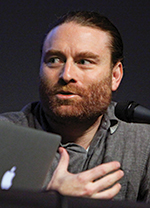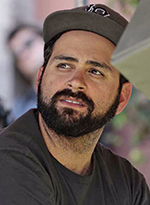BY HUGH HART
When Facebook paid $2 billion for virtual reality company Oculus Rift two years ago, the move signaled a leap-of-faith investment in the future of immersive storytelling.
A radical departure from the flat-screen world of movies, TV, and tablets, VR reaches its audience one headset-wearing viewer at a time by wrapping each audience member in a 360-degree environment. For directors curious about rethinking "rectangular" storytelling habits, virtual reality offers an intriguing array of opportunities.
Demand for VR content could boom once consumers can more easily—and affordably—acquire viewing devices, including Oculus Rift’s own headset (currently selling for $599), Samsung’s Gear VR, Sony’s PlayStation VR, and the budget-priced Google Cardboard. By 2025, the VR content market could rise to nearly $5.4 billion, according to investment bank Piper Jaffray. And by 2018, trend analysis firm CCS Insight predicts, there could be up to 20 million shipments of VR devices. And all those viewers will be hungry for stories
Pioneering VR director Chris Milk, renowned for his tech-savvy music videos, co-founded Vrse.works two years ago to serve as a virtual reality production company, technology incubator, and content-distribution app. Making the transition from flat screen to spherical space requires a fresh mindset, Milk cautions. "One of the bigger hurdles on the VR learning curve is figuring out how to think in moments instead of scenes. In traditional cinema, you tell the audience a story. In VR, you let the audience discover a story. It’s about taking people somewhere and putting them inside of a moment."
Milk has been doing just that in a series of United Nations-backed VR documentaries, including Clouds Over Sidra, which virtually places the viewer in the middle of a Syrian refugee camp. "We learned early on that VR can tap into a viewer’s sense of empathy," Milk says. "With traditional rectangular-framed linear narratives, it’s like you’re looking through a window at a story about people ’over there.’ VR is
like a teleportation device. It puts you face-to-face with a child in a refugee camp, or a band on stage, or a character in a dramatic narrative."
VR’s immersive qualities can also be exploited to chilling effect, as Guy Shelmerdine demonstrated with Catatonic. The five-minute 3-D horror film tours a nightmarish mental hospital from the point of view of a patient strapped into a wheelchair. "VR allows you to put the viewer in the shoes of the protagonist in a way that we’ve never been able to do before," Shelmerdine says. "For me, that’s really exciting."

|
"In traditional cinema, you tell the audience a story. In VR, you let the audience discover a story. It's about taking people somewhere and putting them inside of a moment."
∼ Chris Milk
|
THE TECHNOLOGY
Over the past few months, VR camera systems have advanced rapidly to keep pace with the emerging medium. For Catatonic, Shelmerdine positioned a cluster of eight GoPro cameras at the "head" of his terrified "patient" to capture all four quadrants of the 3-D space. More recently, Shelmerdine has used his own Dark Corner rig, featuring four Sony a7SII cameras, to shoot projects like the gritty drug-smuggler short Mule. Recently introduced stereoscopic VR camera systems also include the Jaunt NEO, Radiant Images’
Headcase, and the Nokia OZO. Veteran director Randal Kleiser (Grease, The Blue Lagoon) switched to the OZO after making the pilot for his 12-episode Defrost series on a GoPro rig.
New advances also include ’live stitching’ software that simplifies production. Previously, filmmakers had to wait for technicians to cobble together four separate panels of digital footage before they could view the full sweep of what they’d shot. Now, directors can immediately see a low-res assembly of their 360-degree material on the fly. "Stitching can be a big headache, because you have to bring all the cameras together in a seamless way so you don’t see the lines where they join," says Kleiser, who centered his VR series on a woman
who wakes up after being frozen for 30 years. "Even though the resolution is low, these live-streaming versions of VR allow you to see what’s being shot from behind the scenes."
Since virtual reality audiences have the ability to look around in
any direction, VR filmmakers are learning to guide the viewer’s attention through an array of techniques. "From a filmmaker’s perspective, I don’t want my audience to be spinning around all the time,’ says Shelmerdine. "When it comes to storytelling, you need to have a very firm objective as to where you want your audience to be looking."
For his U2 music project Song for Someone, Milk shaped the VR
experience through audio. "I used spatialized sound to direct the viewer’s gaze," he says. "If you hear someone singing behind and you turn, the sound dynamically changes to match your movement in relation to the singer. I could cue the audience where to look based on where I place sounds within the sphere."
In his VR commercial for Patrón Tequila, Mark Kudsi used a drone-mounted bundle of GoPro cameras to steer the viewer’s journey from the POV of an airborne bee that flies from guava field to liquor factory. "This was designed almost as a roller coaster in that you’re always moving forward with a one-point perspective so the viewer knows what to look at," he says.
Kleiser likens directing for VR to directing for the stage. "In a theater space, you use sound or lighting or movement in the direction you want the audience to focus on," he says. "In that way, stage directing is perfect training, because with VR, it’s as if you’re doing 360-degree theater for one viewer in the middle. There are ways to compose a shot in VR, but it’s different than framing a shot within a specific aspect ratio."
Compared with traditional film and video, VR engages the viewer’s entire body on a surprisingly visceral level. Because of the medium’s immersive powers, filmmakers need to proceed with caution when it comes to staging action sequences. "Camera movement that spins and accelerates is akin to physically tossing and turning a person in real life," Milk explains. "When that motion does not correlate with what our vestibular system is telling our brain that our body is actually doing, it can lead to motion sickness."
Shrewd VR creators are figuring out how to craft visceral experiences without making the audience dizzy. Catatonic induces gasps when the wheelchair suddenly hovers on the precipice of a staircase. In Evolution of Verse, Milk’s homage to the Lumière brothers’ 1895 Arrival of a Train, film speeds are gently manipulated
to simulate a flying sensation. "I built acceleration into one shot, which is generally not recommended in VR, in order to provide the feeling of being lifted off the ground," Milk says. "Sometimes, we can break the rules ever so slightly to give the viewer a physical sensation that further connects them to the experience they’re having."
Shelmerdine also realized that too many quick cuts make for a bumpy experience. For a Muse music video, he trimmed the number of edits from 140 to just 20 for the VR version of the same performance.
Milk says, "VR seems to give the filmmaker direct access to people’s senses, emotions, and even their bodies, because when we’re immersed in a 360-degree visual and aural environment, our minds process information as if we’re actually experiencing it. With this power comes great responsibility that we take extremely seriously."

|
"This was designed almost as a roller coaster in that you're always moving forward with a one-point perspective."
∼ Mark Kudsi
|
THE BUSINESS MODEL
From a creative standpoint, VR looms as a wide-open playing field, but the business model remains an open question: Who will pay directors to create content? So far, a handful of VR projects have been funded by movie and TV studios, which view the medium as a way to promote their traditional properties. Director Robert Stromberg (Maleficent), for example, teamed with Fox Innovation Lab and producer Ridley Scott to make a 3-D VR experience for The Martian that puts the viewer inside the helmet of the film’s astronaut hero. And CBS recently produced an online VR companion piece for its TV drama Code Black by situating the viewer in the middle of the emergency-room action.
Shelmerdine envisions VR spinoffs as the next step. "You can use VR to take an existing piece of Hollywood intellectual property and revitalize the project by creating a new experience. In the same way you see movies generating TV spinoffs, I think we’re going to see characters being re-explored through virtual reality concepts."
Technology companies are also moving into content creation. Palo Alto, California-based camera maker Jaunt commissioned Doug Liman to create the six-episode Invisible virtual reality series, which will be made available on its app. Samsung teamed with Los Angeles-based Wevr to produce the live-action missing-child adventure Gone, while Chinese media firm HTC has forged a content partnership with gaming company Valve.
During the medium’s formative years, early adopters in the gaming community are likely to drive demand for computer-generated VR experiences like the CGI John Wick project inspired by the 2014 action thriller. Shelmerdine hopes genre
audiences will also flock to live-action VR thrillers. "The horror crowd likes thrilling, provocative, genre-type experiences," he says. "That’s where I’m headed, and I think Hollywood is interested in that as well. We just have to get to the point where enough people have headsets and are willing to pay for VR experiences, which I think is only moments away."